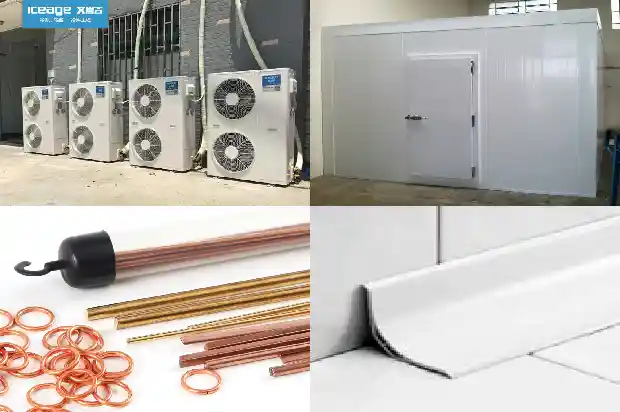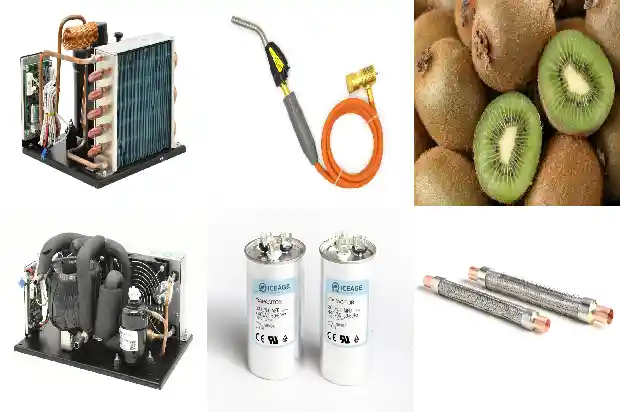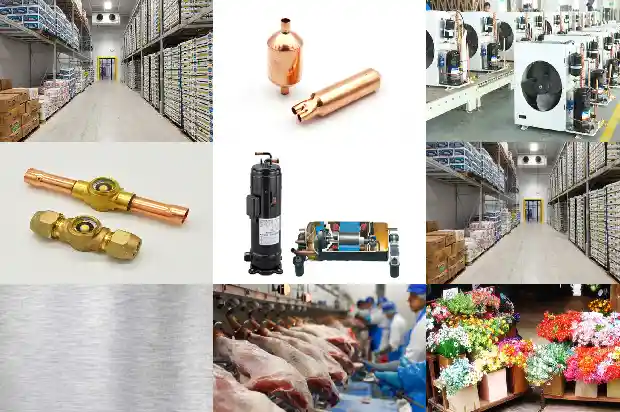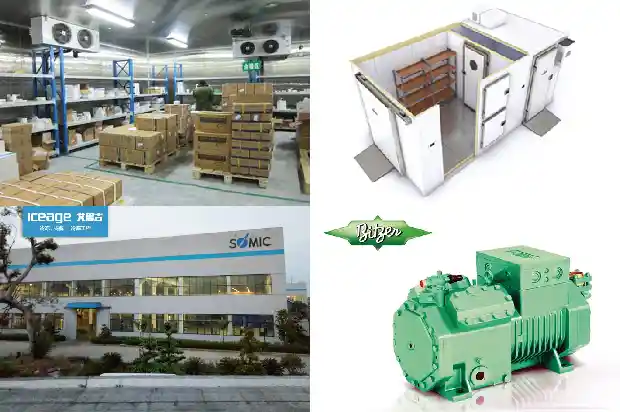Wiring Methods, Faults and Classifications of Fan Coil Units, All Here~~
2025-03-03
I. Introduction to the Classification and Characteristics of Fan Coil Units
The fan coil unit is an end device of the central air conditioning system in a water system, used for comfort air conditioning. It is mainly composed of a heat exchanger, a fan, etc. Its working principle is composed of two circulation systems: the air circulation and the water circulation.
Water Circulation: The chilled water (hot water) coming from the central machine room circulates in the heat exchanger through the water pipe.
Air Circulation: The unit continuously recirculates the air in the room, so that the air is cooled (heated) after passing through the chilled water (hot water) coil to maintain a constant room temperature.
Classification by Structural Form: Vertical type, horizontal type, wall-mounted type, cassette type, etc.;
Classification by Installation Method: Surface-mounted and concealed-mounted;
Classification by Water Inlet Method: Left type and right type.
All wall-mounted fan coil units are surface-mounted units. They are compact in structure and have a good appearance, and are directly hung above the wall.
The vertical cassette (ceiling-embedded) unit has a relatively beautiful inlet and outlet exposed under the ceiling, and the fan, motor and coil are all placed above the ceiling, belonging to a semi-surface-mounted unit; Surface-mounted units all have beautiful casings, with their own air outlets and inlets, and are installed openly in the room; The casings of concealed-mounted units are generally made of galvanized steel sheets.
According to the national standards, fan coil units are divided into two categories according to the static pressure outside the unit: low static pressure type and high static pressure type.
For the low static pressure type unit, the outlet static pressure is 0 or 12pa at the rated air volume. For the unit with an air outlet and a filter, the outlet static pressure is 0; for the unit without an air outlet and a filter, the outlet static pressure is 12pa; for the high static pressure unit, the outlet static pressure at the rated air volume is not less than 30pa.
Principle and Installation
The fan coil unit is an end device of the central air conditioning system in a water system, used for comfort air conditioning. It is mainly composed of a heat exchanger, a fan, etc. Its working principle is composed of two circulation systems: the air circulation and the water circulation.
Water Circulation: The chilled water (hot water) coming from the central machine room circulates in the heat exchanger through the water pipe.
Air Circulation: The unit continuously recirculates the air in the room, so that the air is cooled (heated) after passing through the chilled water (hot water) coil to maintain a constant room temperature.

Classification by Structural Form: Vertical type, horizontal type, wall-mounted type, cassette type, etc.;
Classification by Installation Method: Surface-mounted and concealed-mounted;
Classification by Water Inlet Method: Left type and right type.
All wall-mounted fan coil units are surface-mounted units. They are compact in structure and have a good appearance, and are directly hung above the wall.
The vertical cassette (ceiling-embedded) unit has a relatively beautiful inlet and outlet exposed under the ceiling, and the fan, motor and coil are all placed above the ceiling, belonging to a semi-surface-mounted unit; Surface-mounted units all have beautiful casings, with their own air outlets and inlets, and are installed openly in the room; The casings of concealed-mounted units are generally made of galvanized steel sheets.
According to the national standards, fan coil units are divided into two categories according to the static pressure outside the unit: low static pressure type and high static pressure type.
For the low static pressure type unit, the outlet static pressure is 0 or 12pa at the rated air volume. For the unit with an air outlet and a filter, the outlet static pressure is 0; for the unit without an air outlet and a filter, the outlet static pressure is 12pa; for the high static pressure unit, the outlet static pressure at the rated air volume is not less than 30pa.
Principle and Installation
- The fan coil unit mainly relies on the forced action of the fan to cool or heat the air when it passes through the surface of the heater, thus strengthening the convective heat exchanger between the radiator and the air, and being able to quickly cool or heat the air in the room.
- The control of the fan coil unit mostly adopts the local control scheme, which is divided into two types: simple control and temperature control. Simple control: Use a three-speed switch to directly and manually control the three-speed conversion and start/stop of the fan.
Temperature control: The thermostat automatically controls the opening and closing of the STV series electric two/three-way valve according to the comparison and operation between the set temperature and the actually detected temperature; and controls the three-speed conversion of the fan. Or directly control the three-speed conversion and start/stop of the fan, so as to achieve the purpose of constant temperature by controlling the air volume of the system.
Piping Diagram
II. Common Problems and Solutions
- Troubleshooting of the Fault of No Air at the Air Conditioning Air Outlet:
1.1. Check whether the three-speed switch is damaged; Use an electric pen to measure whether there is electricity at the input and output terminals of the temperature control switch. If it is judged that the temperature control switch is damaged, replace or repair it.
1.2. Check whether the running speed of the motor is normal.
After stopping the machine, feel whether the surface temperature of the fan is normal;
After stopping the machine, manually turn the fan to see if it is flexible. If there is resistance, replace the bearing. If the rotation is normal, replace the starting capacitor.
Measure whether the motor coil is normal. If it is not normal, replace the motor. - Fault Manifestations and Solutions for the Noise of the Air Conditioning:
Noise caused by damaged bearings: Replace the bearings.
Noise generated with the ceiling: Adjust the height of the suspender nuts of the coil fan, or deal with the friction between the air outlet and the ceiling keel.
Noise caused by air in the pipeline: Drain all the air in the pipeline at the exhaust valve of the coil fan, the floor exhaust valve, and the terminal exhaust valve. - Solutions for the Odor of the Air Conditioning
Check and clean the filter screen at the air inlet.
Check whether there is dust on the fins of the coil. If there is dust, clean it.
Check whether there are foreign objects, dust, accumulated water, etc. in the air duct, and clean it to remove the odor. - The Blown Air is Not Cold (Hot) Enough
The temperature gear is improperly set;
There is air in the coil;
The water supply temperature is abnormal;
Insufficient water supply;
The fins of the coil are oxidized. - Water Leakage
The water in the drip pan overflows. Common reasons include: The drainage outlet (pipe) is blocked, and water cannot be drained or the drainage is not smooth.
The drip pan is tilted, the air release valve is not closed, and the connections of each pipe joint are not tight, and the air outlet leaks water. The air outlet can be made of ABS material to deal with the water leakage at the air outlet. - Foreign Objects are Blown Out
There are rusty substances on the surface of the fan blades due to corrosion;
The air filter is damaged and deteriorated;
The thermal insulation material is damaged and deteriorated;
There is too much dust in the unit. - Wiring Methods of Fan Coil Units
Wiring Diagram of the Electric Two-way Valve
This type of two-way valve is normally closed. The water circuit is automatically closed when power is cut off, and the water circuit is opened when powered on, and the air conditioning starts to cool; Therefore, during the wiring process of this two-way valve, it is found that the "off" interface of the wiring terminal of the thermostat does not need to be wired. Disadvantage: The water circuit of the air conditioning needs to be continuously powered on to keep it open, so the service life of the driving head is shortened; Advantage: It is cheap.
Wiring Diagram of the Electric Ball Valve
For this type of electric ball valve, the water circuit only needs to be powered on once for opening and closing. After the action is executed, the power is automatically cut off. Different from the above two-way valve, it does not need to be powered on for a long time for both opening and closing. Advantage: This type of ball valve does not need to be powered on for a long time, and the driving head has a relatively long service life; Disadvantage: The price is relatively high.
Wiring Diagram of the Thermostat without Installing a Two-way Valve
Related Articles
- How Do You Remove Mildew from the Cold Storage? Have You Used These Methods?
- Common Faults in Refrigeration Systems and Handling Methods
- Cleaning Methods of Tubular Coolers
- Oil Cooling Methods and Oil - changing Operation Procedures for Screw Compressors
- Types of Refrigerants and Leak - detection Methods
- Introduction to Inspection and Handling Methods for Refrigerant Leak in Cold Storage
- Three Common Methods for Removing Water Scale from Water - cooled Condensers
- Reasons for Frost Formation in Cold Storage and Defrosting Methods
- Maintenance Methods for Small Modular Cold Storage Failures
- Cleaning Procedures and Methods for Cooling Towers and Heat Exchangers
- Common Cold - chain Storage Methods for Fruit and Vegetable Cold Storage
- Cleaning Methods for Different Types of Condensers in Refrigeration Devices
- Why Should Refrigerant Be Filled in Liquid Form? What Are the Filling Methods?
- For Computer Room Air Conditioners, Besides Air - cooled and Water - cooled, What Other Cooling Methods Are There?
- Maintenance Methods for Faults in Screw Refrigeration Air - conditioner Compressors
- Maintenance Methods for Refrigerant Leak in Air - conditioner Outdoor Unit
- Common Faults and Troubleshooting Methods of the Moving Mechanism of Piston Compressors
- Are you familiar with the detection and maintenance methods of air conditioner components?
